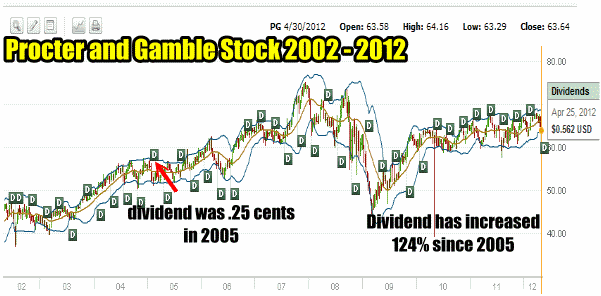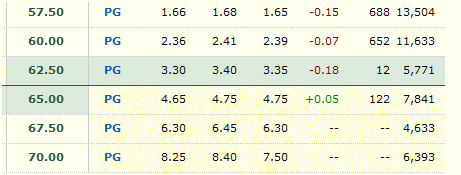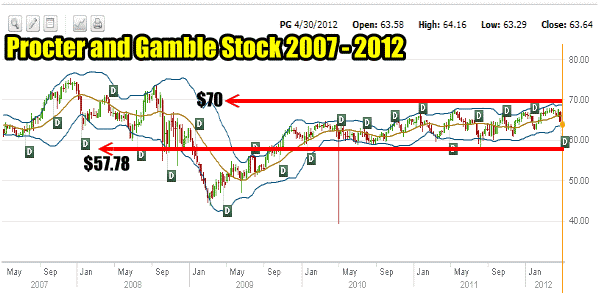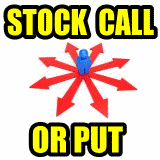Stock Call or Put is a tough decision for many investors. When a stock looks set to bounce is it best to buy the stock, buy a call or sell a put? What about when the stock looks set to fall. Should an investor short the stock, sell a call or buy a put? When it comes to the question of stock call or put strategies they can be tough decisions to figure out and today when I looked at Procter and Gamble Stock it reminded me how often that decision needs to be made.
The recent earnings from Procter and Gamble pushed down the stock. It wasn’t so much the earnings as it was the forward guidance and picking through the earnings numbers. The earnings exceeded analysts estimates by .01 cent but earnings were flat compared to the previous year. The stock fell $2.43 on strong volume marking a 2 month low. It also pushed the stock below its 200 day moving average which often is a sign of weakness in a stock.
Procter and Gamble stock was downgraded to sector perform by Oppenheimer. They had rated the stock as outperform. Other analysts followed suit including Bank Of America which moved their price target on the stock to $72.00, but kept a buy rating on Procter and Gamble Stock. Procter and Gamble is a huge company with a market cap of 175.3 billion. It pays a dividend of $2.25 and trades at 19.8 times earnings. It is a strong company in a non-cyclical industry which is perfect for investors particularly those interested in dividend income.
When a stock this big falls investors invariably ask themselves what is the best strategy to benefit from the fall in the stock. I received a lot of emails regarding would I recommend stock call or put trades. To assist that decision-making process here are some stock call or put investing strategies readers may want to consider.
Stock Call Or Put Decision Process
Stock Call Or Put Decision Should Include Dividend Payouts
If you are a dividend investor then you may want to consider the $2.25 dividend Procter and Gamble Stock pays. This stock has seen significant annual dividend increases. In 2005 Procter and Gamble Stock was paying a $1.00 dividend. Today that dividend has more than doubled to $2.25. That marks a 124% increase! So when deciding whether stock call or put strategies should be used, consider the dividend payout and those annual increases.

Stock Call Or Put Decision Making Process might include dividend payouts
If building a dividend stock portfolio is your goal, then Procter and Gamble Stock should fit into that portfolio.
Stock Call Or Put Decision Might Include Buying The Stock At A Discount
When readers wrote me about whether I would consider stock call or put strategies due to the recent fall of Procter and Gamble Stock I really thought about the dividend. If the dividend payout is a factor in your decision whether to go for the stock call or put on a stock, consider that perhaps it would be better to buy the stock through selling puts to get it at a discount to the present price. Procter and Gamble recently sold off which could be a perfect time to sell put options and be assigned shares at a discount to today’s price. When looking at stock call or put as the best strategy instead of simply buying the stock and earning the dividend, why not sell a longer term put and get into the stock at a discount and be paid to do it.
For example, looking back 1 year, I can see that Procter and Gamble stock traded between about $60 to $66.50 as a median range. As a way to get into the stock at a discount why not consider the mid-range price point of $62.50.

IMAGE 1 When making a stock call or put decision on a stock consider selling puts to get into the stock at a discount.
For example, today (May 1 2012) Procter and Gamble Stock closed at $63.64. If I want to buy the stock for $62.50 I could consider a couple of different strategies.
Below are the January 2013 put option premiums as of the market close of May 1 2012. If the goal is to enter the stock for $62.50, I could approach it two difference ways. I could sell the January $62.50 put for $3.30. This provides an immediate return of 5.2% and would make my average cost in the stock $59.20. Considering that the low in Procter and Gamble Stock this year was $57.56, $59.20 seems like a nice entry price. As well earning 5.2% for the next 9 months is not bad either considering money market rates.

When deciding on what put strikes to sell, there are a number of strategies to consider when selling puts. These are the Jan 2013 put option premiums for Procter and Gamble Stock at the market close on May 1 2012
However if I felt that Procter and Gamble Stock was going to climb from today’s price of $63.64 to perhaps $65.00 which is still below the high-end of this year’s range (see image 1 above), I could consider selling the Jan 2013 $65 put. I immediately receive $4.65 for a 7.1% return and my cost to enter the stock is at $65 – $4.65 = $60.35 which is still at a discount to my goal of entering at $62.50.
When making a decision of stock call or put, you can see that there are different strategies that can be employed. Even selling the $67.50 Procter and Gamble Stock put for $6.30 would place me in the stock at $61.20 which is still below my goal of $62.50. At $6.30 for the $67.50 put I am earning 9.3% over the next 9 months or almost 1% a month.
Stock Call Or Put Decision And Selling In The Money Puts
So why sell in the money puts? It all depends on your outlook for the stock. If the goal is to buy stock and get the dividend and hope for a rise in the stock and then sell out the stock, then fine, sell an out of the money put and wait the 9 months. But if the goal is to build a dividend portfolio there are significant benefits to selling deep in the money puts. At $67.50 I would be selling puts at the high-end of the stock range for this year since Procter and Gamble Stock this year set a high of $67.95. If however the stock rises to $65 or $66 dollars by January 2013, I will still own the stock for $61.20 by selling the $67.50 put and I can turn around and sell a call once I pick up the shares OR I can roll the stock again, out another year.
For example:
Procter and Gamble Stock January 2013 – $65.00
Premium Earned on the $67.50 put – $6.30
My Cost Basis in the stock – $61.20
Total earned by January 2013 if the stock is at $65.00 =
$65.00 – $67.50 = -2.50 + 6.30 (put sold) = $3.80.
Then I can consider a covered call if I accepted the shares in January. Based on call options from today and looking at the chart in image 1 above, I would probably sell the call option for $67.50. With the stock presently at $63.64, and looking at today’s call options below, I would probably earn about $2.00 for the call if Procter and Gamble Stock was at $65 by January 2013.

Procter and Gamble Stock Call Options For January 2013 as of May 1 2012
That means I would earn $3.80 until January 2013, $2.00 for a 1 year covered call which I would put into play in January 2013 and I would earn the dividend of $2.25. Total earnings would be $8.05 for the next 21 months. My cost basis of the stock would be $67.50 (assigned price) less $8.05 = $59.45.
Stock Call Or Put Trade On Procter and Gamble Stock
But wait there is a lot more to the stock call or put trade to consider. Why not do all three?
Perhaps you are trying to build a dividend portfolio and would like to own 500 shares of stock. Let’s consider the same stock price goal of ownership at $62.50. If I was going to purchase 500 shares today I would need $31,250.00 to purchase shares. This would allow me to earn the dividend on the 500 shares and would commence my dividend stock portfolio immediately. But why rush.
Instead consider buying 200 shares now at $63.64 and sell two covered calls, one out to Jan 2013 at $67.50 for $1.17 (today’s price) and another to January 2014 at $70.00 for $1.86 (today’s price). Then sell 3 puts to eventually own shares in the stock. I would sell one July 2013 $62.50 put for $1.23, one Jan 2013 $60.00 put for $2.36 and one Jan 2014 $57.50 put for $3.90. Here then is how this stock call or put trade would look:
Stock Call Or Put Trade On Procter and Gamble Stock Status: (no commissions taken into account)
200 shares at $63.64 = ($12,728.00) – SPENT
1 covered call Jan 2013 $67.50 = $117.00 – INCOME
1 covered call Jan 2014 $70.00 = $186.00 – INCOME
1 Naked Put Jul 2013 $62.50 = $123.00 – INCOME
1 Naked Put Jan 2013 $60.00 = $236 – INCOME
1 Naked Put Jan 2014 $57.50 = $390 – INCOME
Dividend Income to Jan 2014 (based on today’s dividend rate) = $786.80
Total income earned = $1838.80
Total Capital Needed if Assigned On All Naked Puts = $18000.00
Total Capital Spent On Original Purchase of 200 shares = $12728.00
Less Income Earned = $1838.80
Total Capital Required for 500 shares = $28889.20
Cost basis of each share = $57.78.
The original trade if I had just bought the shares would have required $31250.00. Instead I would only need $28890.00 and I would own the 500 shares 21 months later at an average cost of $57.78, which by looking at the Procter and Gamble Stock Performance 5 Year Chart Below you can see would place me near the low-end of the historic prices for this stock. Yet by selling covered calls at the high-end of the range ($67.50 to $70) I have a better than average chance that the covered calls will expire out of the money or can be rolled if caught in the money.

Procter and Gamble Stock Performance Chart For The Past 5 Years shows that through using a combination of stock call and put I can place myself lower into the stock reducing my cost and preparing to earn the substantial dividend.
Stock Call or Put Summary
This is just a short example of what is possible when an investor steps back from a trade and asks what is best, stock call or put. In the end I think the best solution for those investors who are building a dividend portfolio is to combine stock call or put into one trade and use all three investment strategies to place themselves at the low-end of the Procter and Gamble Stock Performance Range.
Once the trade is in place, the investor will have time and opportunity to roll puts or covered calls as the months pass and the trade unfolds. There are so many variations that can be used with stock call or put strategies when the goal is ownership of stock at a greatly reduced price from present valuations while earning a growing dividend which you can tuck away in your dividend portfolio for years to come. For interested investors who might be consider Procter and Gamble Stock dividend select this stock call or put link to visit PG Stock investor relations.
Review Profit And Income Strategies Index For More Investment Strategies

